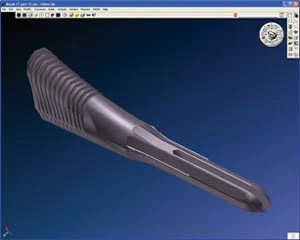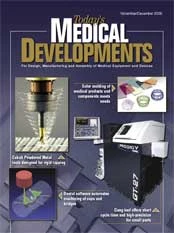
Individuals interested in purchasing CAD/ CAM systems, as well as end-users, want to know what trends are developing in the industry. To answer this question, I start by saying that I don't expect radical changes to occur. Then, I introduce another topic that I refer to as "Power to the Machinist." Of course, this sounds revolutionary or even radical and generates considerable interest. So, let me explain.
Today, the world of "parts" has three primary computer application phases:
Design CAD (Computer-Aided Design), Manufacturing CAD, and CAM (Computer-Aided Manufacturing). CAD can work with wireframe or surface geometry and/ or solid models. Products are best evaluated for a specific user and a specific task. With Design CAD, the task is designing a new thing. The user is a design engineer of some sort. Manufacturing CAD takes an existing design, and potentially modifies it for manufacturability, as well as creating tooling, molds, dyes, and more. The Manufacturing CAD user is a manufacturing engineer or a CNC programmer/machinist. CAM starts with the manufacturing model, develops a manufacturing strategy, verifies it and then creates a toolpath for a specific CNC machine tool. The user is a manufacturing engineer or CNC programmer/machinist. Various products package these functions differently. For example, GibbsCAM is an integrated CAD/CAM product with its own Parasolid-based solid modeling capabilities. But, its CAD capabilities are not focused on the needs of Design CAD, rather they're focused on Manufacturing CAD, as GibbsCAM's CAD user is the same individual as GibbsCAM's CAM user.
The CAD/CAM market is divided into several significant segments. The largest segment, by revenue, is the integrated MCAE systems that provide all-inclusive, monolithic solutions from design to analysis to manufacturing. These are the products of choice for large companies, who find that the advantages of a single vendor product outweigh their lack of CAM specialization and efficiency. The second market segment is integrated CAD/CAM software, where third parties integrate CAM functionality into a CAD system. In both cases, the CAM software is integrated on top of the CAD system, providing extra utility to a user of both products. The third segment is the CAM focused product. These best-in-class CAM systems are products that compete on their CAM expertise, and stand prepared to accept CAD data from any source. GibbsCAM is an example of this third segment. While there are numerous reasons why GibbsCAM took this approach in relation to CAD, the primary reason was that it allowed for the development of CAD capabilities aimed at the manufacturing user and the manufacturing task. Mainstream, PC-based CAD products are Design CAD products focused on a different user and a different task. You can use any product for any purpose, but you don't necessarily gain the best solution for your needs. Even in large companies, it's rare for the design engineer and the manufacturing person to be the same individual. They are usually people of different experience, different education and with different tasks. So rather than force them to learn a complex Design CAD system, GibbsCAM offers them a manufacturing focused CAD tool. Our original motto, which still holds true today, is "CAD/ CAM for machinists".
There is another aspect of CAD/CAM that is worth mentioning. It seems that design engineers influence the bulk of CAD/CAM research and development in the world today. The problem with this is that few design CAD experts understand how to make a part. They don't understand what goes into developing a manufacturing process and designing methods to manufacture parts cost effectively. As a result, it is common for these CAD/ CAM leaders to drastically underestimate the value of manufacturing engineering, especially in their CAD/ CAM software design. The most common misconception of this is that one day we'll hit a button and it will create CNC programs automatically, replacing the manufacturing user. While this may happen some day, I don't see it happening anytime soon, especially for parts with any complexity. The flaw in this concept is that it underestimates the difficulty of the task, and as we know, manufacturing is a complex task. Complex tasks require creativity, critical thinking and knowledge bases. Computers are not especially good at creativity, critical thinking, or for that matter, knowledge bases. People are good at all three. So rather than chase this idea of "automatic programming" to replace a manufacturing expert, GibbsCAM is focused on providing powerful tools for the manufacturing user. There is much that can be automated and simplified by CAM software, but at the end of the day we expect our manufacturing user to be driving and making the key decisions. At Gibbs, it is our goal to empower the manufacturing user.
So what's next? For years the most important question in selecting CAM software was "can you program my part?" And for years, this was enough because CAM software had many limitations. Today things are different. Many CAM software products can program your part. And as the CAM market continues to improve, it becomes harder to differentiate between them. So, you have to expand your questions to include "will my people be able to program my parts, quickly and easily with this CAM software?" In addition, you will need to look into support and service levels. Price will always be an issue, but purchase price is such a small issue compared to the cost of training, machine downtime and of part run-time. CAM software can vary widely on these issues; therefore, your initial purchase decision is important because it controls what comes next. In practice, your buying decision is actually a form of evolution. Products that become popular can afford more development money and set the standard that other companies follow. Of course, product popularity is not based solely on product quality, but also on marketing and sales channels. It's an interesting idea that the future of CAM is being directly influenced by the end user, and the products end users choose to buy.
To wrap this up, here are a few predictions. There will be fewer CAM companies in the future. We will see increasing sales of multi-task CNC machines to reduce labor costs. This will be possible because CAM software is available to reduce setup and programming costs. Finally, the CAM companies that survive will do so by providing better products, which not only encompasses better technology, but also better service and support.

Explore the November December 2006 Issue
Check out more from this issue and find your next story to read.
Latest from Today's Medical Developments
- Arcline to sell Medical Manufacturing Technologies to Perimeter Solutions
- Decline in German machine tool orders bottoming out
- Analysis, trends, and forecasts for the future of additive manufacturing
- BlueForge Alliance Webinar Series Part III: Integrate Nationally, Catalyze Locally
- Robot orders accelerate in Q3
- Pro Shrink TubeChiller makes shrink-fit tool holding safer, easier
- Revolutionizing biocompatibility: The role of amnion in next-generation medical devices
- #56 Lunch + Learn Podcast with Techman Robot + AMET Inc.





